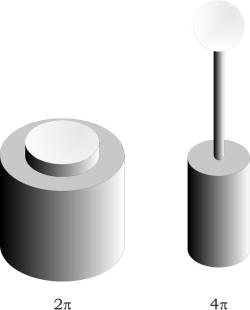PAR Detectors
Photosynthetic irradiance is the radiant flux density of PAR and is expressed as the radiant energy (400–700 nm) incident on a unit of surface per unit time. A PAR detector is typically an irradiance detector that is equally sensitive to light between 400 and 700 nm and insensitive to light outside this region. Irradiance is now internationally expressed in moles of photons per unit area and per unit time as µmol m
-2 sec
-1 (formerly µEinsten m
-2 sec
-1), where 1 µmol (µEinsten) corresponds to 1 micromole of photons, that is, 6.02 x 10
17 photons, at a given wavelength. Modern instruments measure in situ irradiance flux densities directly in µmol m
-2 sec
-1.
In terms of collector geometry, a PAR detector is usually equipped with either a planar (cosine) or a spherical (scalar) collector. A planar or 2π collector measures PAR in a 180° arc while a spherical or 4π collector measures the light impinging from all directions on a single point (Figure 5.14).

FIGURE 5.14 Examples of PAR detectors equipped with a planar 2π collector or with a spherical 4π collector.
The irradiance impinging on the surface of the water or sediment is commonly measured with a planar detector. Spherical detectors provide a measurement of the amount of light available for photosynthesis by phytoplankton suspended in the water column. A leaf resembles a small planar collector whereas algae resemble small spherical collectors.
Direct solar radiation reaching the water surface varies with the angular height of the radiation and therefore, with the time of day, season, and latitude. The quantity and quality of light also vary with the molecular transparency of the atmosphere and the distance the light must travel through it; therefore, it varies with altitude and meteorological conditions. In water, upwelling (bottom reflected radiance) and downwelling (depth attenuated radiance) irradiance are usually quantified using paired cosine collectors mounted on a frame that is lowered in the water column. Spherical collectors are also mounted on a frame and lowered in the water to obtain light profiles. For photophysiological studies, spherical collectors provide a realistic measure of the total amount of PAR available for photosynthesis in a water body.
Accurate measurement of photosynthetic radiation is essential for controlled environmental research. The most common method of measuring PAR gives equal value, that is, equal energy content, to all photons with wavelength between 400 and 700 nm and is referred to as the photosynthetic photon flux (PPF) measured in µmol m
-2 sec
-1.
The ideal PPF sensor would respond equally to all photons between 400 and 700 nm. However, photosynthesis is driven also by
photons with wavelength below 400 and above 700 nm, and photons of different wavelength induce inequal amount of photosynthesis. For these reasons, an accurate measurement of PAR should follow the relative quantum efficiency (RQE) curve, which weights the photosynthetic value of all photons with wavelength from 360 to 760 nm. The RQE resembles the absorption spectrum of the absorbing algal structures. A sensor that responds according to this curve measures yield photon flux (YPF) in micromoles per square meter per second, the same unit of PPF.
Detector designed to measure YPF or PPF are commercially available. Both types consist of an optical diffuser collector (planar or spherical) and multiple-spectral filters in front of a broadspectrum photovoltaic detector.
Planar detectors measure only unreflected sunlight. They should possess cosine corrected response; as the light impinging on the measurement plane is proportional to the cosine of the angle at which the light is incident, the response of the detector must also be proportional to the cosine of the incidence angle [Equation (5.22)]. An integrating sphere measures both unreflected and all the scattered sunlight; it needs no corrections because it is the ideal cosine detector, responding equally to light coming from all directions.
The peak responsivity and bandwidth of a detector can be controlled through the use of filters. Filters can suppress out-of-band light but cannot boost signal, and restricts the spatial responsivity of the detector. Filters operate by absorption or interference. Colored glass filters are doped with materials that selectively absorb light by wavelength, and obey Lambert–Beer law. The peak transmission is inherent to the additives, while bandwidth is dependent on thickness. Interference filters, which select very narrow bandwidths, rely on thin layers of dielectric to cause constructive interference between the wavefronts of the incident white light. So by varying filter thickness, we can selectively modify the spectral responsivity of a detector to match a particular function. Pass band filters are often used to select a specific wavelength radiation. Any of these filter types can be combined to form a composite filter that matches a particular photobiological process. Multiple filters cemented in layers give a net transmission equal to the product of the individual transmissions. The detector’s overall spectral sensitivity is equal to the product of the responsivity of the detector and the transmission of the filters. Given a desired overall sensitivity and known detector responsivity,
we can solve for the ideal filter transmission curve.
Different measurement geometries necessitate specialized input optics. Radiance and luminance measurements require a narrow viewing angle (<4°) in order to satisfy the conditions underlying the measurement units. Power measurements, on the other hand, require a uniform response to radiation regardless of input angle to capture all the light.





